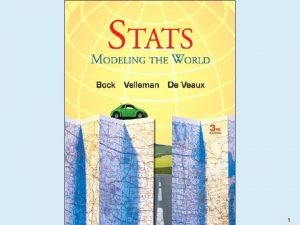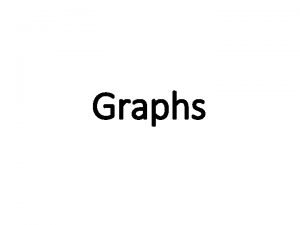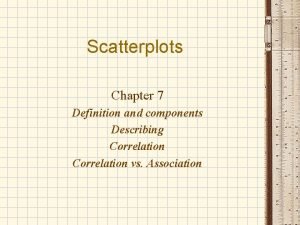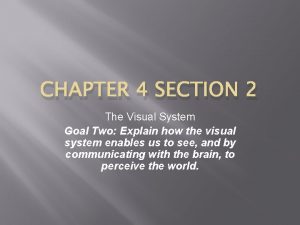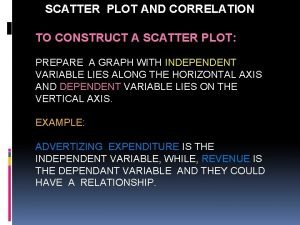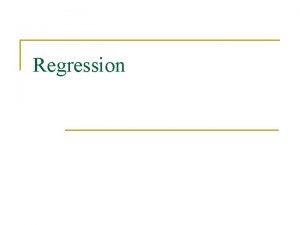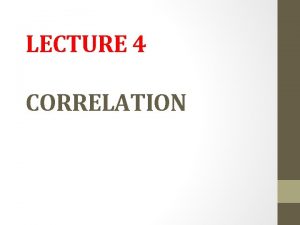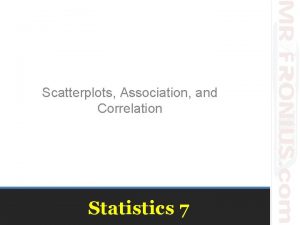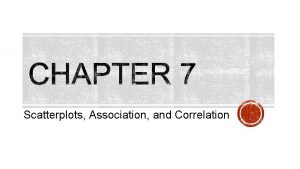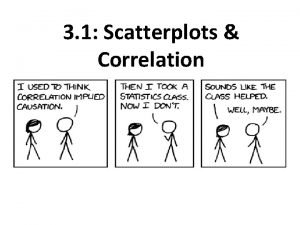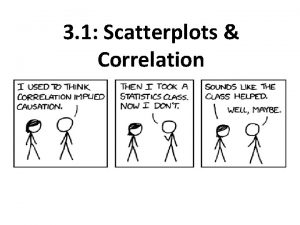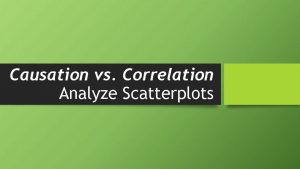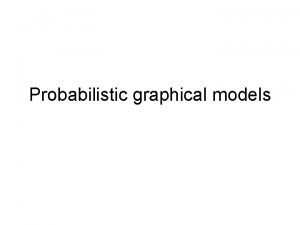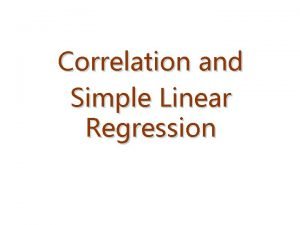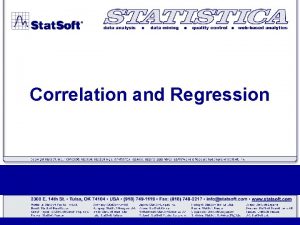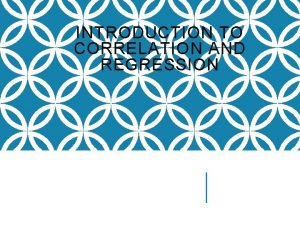Chapter 7 Scatterplots and Correlation Scatterplots graphical display






















- Slides: 22

Chapter 7 Scatterplots and Correlation Scatterplots: graphical display of bivariate data Correlation: a numerical summary of bivariate data

Objectives Chapter 7 Scatterplots p Explanatory and response variables p Interpreting scatterplots p Outliers p Categorical variables in scatterplots

Chapter 7 Basic Terminology p Univariate data: 1 variable is measured on each sample unit or population unit e. g. height of each student in a sample p Bivariate data: 2 variables are measured on each sample unit or population unit e. g. height and GPA of each student in a sample; (caution: data from 2 separate univariate samples is not bivariate data)

Basic Terminology (cont. ) p Multivariate data: several variables are measured on each unit in a sample or population. q For each student in a sample of NCSU students, measure height, GPA, and distance between NCSU and hometown; p Focus on bivariate data in chapter 7

Same goals with bivariate data that we had with univariate data p Graphical displays and numerical summaries p Seek overall patterns and deviations from those patterns p Descriptive measures of specific aspects of the data

Here, we have two quantitative variables for each of 16 students. Student Beers Blood Alcohol 1 5 0. 1 2 2 0. 03 1) How many beers they drank, and 3 9 0. 19 4 7 0. 095 5 3 0. 07 2) Their blood alcohol level (BAC) 6 3 0. 02 7 4 0. 07 8 5 0. 085 9 8 0. 12 10 3 0. 04 11 5 0. 06 12 5 0. 05 13 6 0. 1 14 7 0. 09 15 1 0. 01 16 4 0. 05 We are interested in the relationship between the two variables: How is one affected by changes in the other one?

Scatterplots p Useful method to graphically describe the relationship between 2 quantitative variables

Scatterplot: Blood Alcohol Content vs Number of Beers In a scatterplot, one axis is used to represent each of the variables, and the data are plotted as points on the graph. Student Beers BAC 1 5 0. 1 2 2 0. 03 3 9 0. 19 4 7 0. 095 5 3 0. 07 6 3 0. 02 7 4 0. 07 8 5 0. 085 9 8 0. 12 10 3 0. 04 11 5 0. 06 12 5 0. 05 13 6 0. 1 14 7 0. 09 15 1 0. 01 16 4 0. 05

Focus on Three Features of a Scatterplot Look for an overall pattern regarding … 1. Shape - ? Approximately linear, curved, up-and-down? 2. Direction - ? Positive, negative, none? 3. Strength - ? Are the points tightly clustered in the particular shape, or are they spread out? Blood Alcohol as a function of Number of Beers … and deviations from the overall pattern: Outliers Blood Alcohol Level (mg/ml) 0, 20 0, 18 0, 16 0, 14 0, 12 0, 10 0, 08 0, 06 0, 04 0, 02 0, 00 0 1 2 3 4 5 6 Number of Beers 7 8 9 10

Scatterplot: Fuel Consumption vs Car Weight. x=car weight, y=fuel p (xi, yi): (3. 4, 5. 5) (3. 8, 5. 9) (4. 1, 6. 5) (2. 2, 3. 3) cons. (2. 6, 3. 6) (2. 9, 4. 6) (2, 2. 9) (2. 7, 3. 6) (1. 9, 3. 1) (3. 4, 4. 9) FUEL CONSUMP. (gal/100 miles) FUEL CONSUMPTION vs CAR WEIGHT 7 6, 5 6 5, 5 5 4, 5 4 3, 5 3 2, 5 2 1, 5 2, 5 WEIGHT (1000 lbs) 3, 5 4, 5

Explanatory and response variables response variable the variable of interest. explanatory variable explains changes in the response variable. Typically, the explanatory (or independent variable) is plotted on the x axis, and the response (or dependent variable) is plotted on the y axis. Blood Alcohol as a function of Number of Beers Blood Alcohol Level (mg/ml) 0, 20 Response (dependent) variable: blood alcohol content 0, 18 0, 16 0, 14 0, 12 0, 10 0, 08 0, 06 0, 04 0, 02 y 0, 00 0 x 1 2 3 4 5 6 7 8 9 10 Number of Beers Explanatory (independent) variable: number of beers

SAT Score vs Proportion of Seniors Taking SAT Average SAT Score SAT Total 1350 IW IL 1250 NC 74% 1010 1150 1050 DC 950 0% 20% 40% 60% Percent of Seniors Taking SAT 80% 100%

Correlation: a numerical summary of bivariate data when both variables are quantitative. Correlation p The correlation coefficient “r” p r does not distinguish x and y p r has no units p r ranges from -1 to +1 p Influential points

The correlation coefficient "r" The correlation coefficient is a measure of the direction and strength of the linear relationship between 2 quantitative variables. It is calculated using the mean and the standard deviation of both the x and y variables. Correlation can only be used to describe quantitative variables. Categorical variables don’t have means and standard deviations.

Correlation: Fuel Consumption vs Car Weight FUEL CONSUMPTION vs CAR WEIGHT FUEL CONSUMP. (gal/100 miles) r =. 9766 7 6, 5 6 5, 5 5 4, 5 4 3, 5 3 2, 5 2 1, 5 2, 5 WEIGHT (1000 lbs) 3, 5 4, 5

Example: calculating correlation p p (x 1, y 1), (x 2, y 2), (x 3, y 3) (1, 3) (1. 5, 6) (2. 5, 8)

Properties of Correlation p p p r is a measure of the strength of the linear relationship between x and y. No units [like demand elasticity in economics (-infinity, 0)] -1 < r < 1

Properties (cont. ) r ranges from -1 to+1 "r" quantifies the strength and direction of a linear relationship between 2 quantitative variables. Strength: how closely the points follow a straight line. Direction: is positive when individuals with higher X values tend to have higher values of Y.

Properties of Correlation (cont. ) p r = -1 only if y = a + bx with slope b<0 p r = +1 only if y = a + bx with slope b>0 y = 1 + 2 x r=1 r = -1 10 9 8 7 6 y 5 4 3 2 1 0 20 y = 11 - x Y 15 10 5 0 0 2 4 6 x 8 10 0 2 4 6 X 8 10

Properties (cont. ) High correlation does not imply cause and effect CARROTS: Hidden terror in the produce department at your neighborhood grocery p p p Everyone who ate carrots in 1920, if they are still alive, has severely wrinkled skin!!! Everyone who ate carrots in 1865 is now dead!!! 45 of 50 17 yr olds arrested in Raleigh for juvenile delinquency had eaten carrots in the 2 weeks prior to their arrest !!!

Properties (cont. ) Cause and Effect p There is a strong positive correlation between the monetary damage caused by structural fires and the number of firemen present at the fire. (More firemen-more damage) p Improper training? Will no firemen present result in the least amount of damage?

Properties (cont. ) Cause and Effect (1, 2) (24, 75) (1, 0) (18, 59) (9, 9) (3, 7) (5, 35) (20, 46) (1, 0) (3, 2) (22, 57) x = fouls committed by player; y = points scored by same player p r measures the strength of the linear relationship between x and y; it does not indicate cause and effect The correlation is due to a third “lurking” variable – playing time (x, y) = (fouls, points) correlation r =. 935 Points p 80 70 60 50 40 30 20 10 0 0 5 10 15 Fouls 20 25 30
 Chapter 7 scatterplots association and correlation
Chapter 7 scatterplots association and correlation Chapter 7 scatterplots association and correlation
Chapter 7 scatterplots association and correlation Negative and positive correlation
Negative and positive correlation Positive correlation versus negative correlation
Positive correlation versus negative correlation Paradigm of interaction examples
Paradigm of interaction examples Graphical display of data using bars of different heights
Graphical display of data using bars of different heights The practice of statistics third edition
The practice of statistics third edition Plasma panel display in computer graphics
Plasma panel display in computer graphics Raster and random scan
Raster and random scan Raster scan display and vector scan display
Raster scan display and vector scan display Describing scatterplots
Describing scatterplots 2-1 interpret scatterplots
2-1 interpret scatterplots Chapter 3 describing relationships answer key
Chapter 3 describing relationships answer key Introduction to bivariate data
Introduction to bivariate data Types of interior displays
Types of interior displays Chapter 18 visual merchandising and display
Chapter 18 visual merchandising and display Monocular cues
Monocular cues Chapter 18 visual merchandising and display
Chapter 18 visual merchandising and display Beggs and brill pressure drop calculation
Beggs and brill pressure drop calculation Eq and iq correlation
Eq and iq correlation Scatter plot and correlation
Scatter plot and correlation Difference between regression and correlation
Difference between regression and correlation Height to shoe size calculator
Height to shoe size calculator

